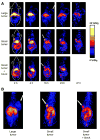PET Imaging of Angiogenesis
- PMID: 20046926
- PMCID: PMC2753532
- DOI: 10.1016/j.cpet.2009.04.011
PET Imaging of Angiogenesis
Abstract
Angiogenesis is a highly-controlled process that is dependent on the intricate balance of both promoting and inhibiting factors, involved in various physiological and pathological processes. A comprehensive understanding of the molecular mechanisms that regulate angiogenesis has resulted in the design of new and more effective therapeutic strategies. Due to insufficient sensitivity to detect therapeutic effects by using standard clinical endpoints or by looking for physiological improvement, a multitude of imaging techniques have been developed to assess tissue vasculature on the structural, functional and molecular level. Imaging is expected to provide a novel approach to noninvasively monitor angiogenesis, to optimize the dose of new antiangiogenic agents and to assess the efficacy of therapies directed at modulation of the angiogenic process. All these methods have been successfully used preclinically and will hopefully aid in antiangiogenic drug development in animal studies. In this review article, the application of PET in angiogenesis imaging at both functional and molecular level will be discussed. For PET imaging of angiogenesis related molecular markers, we emphasize integrin alpha(v)beta(3), VEGF/VEGFR, and MMPs.
Figures




Similar articles
-
Ligands for mapping alphavbeta3-integrin expression in vivo.Acc Chem Res. 2009 Jul 21;42(7):969-80. doi: 10.1021/ar800243b. Acc Chem Res. 2009. PMID: 19489579
-
64Cu-Labeled 1,4,7,10-Tetraazacyclododedane-N,N’,N’’,N’’’-tetraacetic acid–conjugated vascular endothelial growth factor A isoform 121-gelonin fusion protein.2011 Jul 6 [updated 2011 Aug 10]. In: Molecular Imaging and Contrast Agent Database (MICAD) [Internet]. Bethesda (MD): National Center for Biotechnology Information (US); 2004–2013. 2011 Jul 6 [updated 2011 Aug 10]. In: Molecular Imaging and Contrast Agent Database (MICAD) [Internet]. Bethesda (MD): National Center for Biotechnology Information (US); 2004–2013. PMID: 21850782 Free Books & Documents. Review.
-
Vascular endothelial growth factor A isoform 121-gelonin fusion protein–conjugated manganese ferrite nanoparticles.2011 Jul 6 [updated 2011 Aug 17]. In: Molecular Imaging and Contrast Agent Database (MICAD) [Internet]. Bethesda (MD): National Center for Biotechnology Information (US); 2004–2013. 2011 Jul 6 [updated 2011 Aug 17]. In: Molecular Imaging and Contrast Agent Database (MICAD) [Internet]. Bethesda (MD): National Center for Biotechnology Information (US); 2004–2013. PMID: 21866611 Free Books & Documents. Review.
-
Noninvasive Evaluation of Angiogenesis and Therapeutic Response after Hindlimb Ischemia with an Integrin-Targeted Tracer by PET.Rev Cardiovasc Med. 2022 Dec 14;23(12):408. doi: 10.31083/j.rcm2312408. eCollection 2022 Dec. Rev Cardiovasc Med. 2022. PMID: 39076662 Free PMC article.
-
Targeting Angiogenesis in Cancer Therapy: Moving Beyond Vascular Endothelial Growth Factor.Oncologist. 2015 Jun;20(6):660-73. doi: 10.1634/theoncologist.2014-0465. Epub 2015 May 22. Oncologist. 2015. PMID: 26001391 Free PMC article. Review.
Cited by
-
18F-AlF Labeled Peptide and Protein Conjugates as Positron Emission Tomography Imaging Pharmaceuticals.Bioconjug Chem. 2018 Apr 18;29(4):953-975. doi: 10.1021/acs.bioconjchem.7b00817. Epub 2018 Mar 9. Bioconjug Chem. 2018. PMID: 29463084 Free PMC article. Review.
-
Radiolabeling of a cyclic RGD (cyclo Arg-Gly-Asp-d-Tyr-Lys) peptide using sodium hypochlorite as an oxidizing agent.J Labelled Comp Radiopharm. 2016 Sep;59(11):462-6. doi: 10.1002/jlcr.3431. Epub 2016 Aug 31. J Labelled Comp Radiopharm. 2016. PMID: 27577980 Free PMC article.
-
Preclinical imaging: an essential ally in modern biosciences.Mol Diagn Ther. 2014 Apr;18(2):153-73. doi: 10.1007/s40291-013-0062-3. Mol Diagn Ther. 2014. PMID: 24146172 Review.
-
A Systematic Comparative Evaluation of 68Ga-Labeled RGD Peptides Conjugated with Different Chelators.Nucl Med Mol Imaging. 2018 Apr;52(2):125-134. doi: 10.1007/s13139-017-0499-0. Epub 2017 Dec 5. Nucl Med Mol Imaging. 2018. PMID: 29662561 Free PMC article.
-
Decoding Tumor Angiogenesis for Therapeutic Advancements: Mechanistic Insights.Biomedicines. 2024 Apr 9;12(4):827. doi: 10.3390/biomedicines12040827. Biomedicines. 2024. PMID: 38672182 Free PMC article. Review.
References
-
- Folkman J. Angiogenesis in cancer, vascular, rheumatoid and other disease. Nat Med. 1995 Jan;1(1):27–31. - PubMed
-
- Atluri P, Woo YJ. Pro-angiogenic cytokines as cardiovascular therapeutics: assessing the potential. BioDrugs. 2008;22(4):209–222. - PubMed
-
- Pathak AP, Gimi B, Glunde K, Ackerstaff E, Artemov D, Bhujwalla ZM. Molecular and functional imaging of cancer: Advances in MRI and MRS. Methods Enzymol. 2004;386:3–60. - PubMed
-
- Rajagopalan S, Trachtenberg J, Mohler E, et al. Phase I study of direct administration of a replication deficient adenovirus vector containing the vascular endothelial growth factor cDNA (CI-1023) to patients with claudication. Am J Cardiol. 2002 Sep 1;90(5):512–516. - PubMed
-
- Ferrara N. Vascular endothelial growth factor: basic science and clinical progress. Endocr Rev. 2004 Aug;25(4):581–611. - PubMed
Grants and funding
LinkOut - more resources
Full Text Sources
